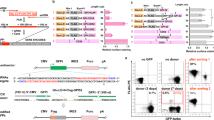Abstract
The process of apoptosis is carefully controlled in cells, and different cell types display different sensitivities to pro-apoptotic stimuli. The prospect of exploiting such differences for treatment of diseases such as cancer, via novel therapeutic agents, is extremely attractive. Therefore, genetic selections for novel expression products that kill cells may have considerable value. However, such selections are difficult to devise and perform because the selected cells do not grow. We developed a selection scheme designed to enrich for genetic agents that kill cells. The selection is based on detachment of apoptotic cultured mammalian cells from adherent monolayers. We characterized the properties of these detached cells (floating cells), and various aspects of the selection process. This selection method is potentially applicable to many mammalian cell lines.
Similar content being viewed by others
References
Evans GI, Vousdan KH. Proliferation, cell cycle and apoptosis in cancer. Nature 2001; 17:411(6835): 342–348.
Metzstein MM, Stanfield GM, Horvitz HR. Genetics of programmed cell death in C. elegans: Past, present and future. Trends Genet 1998; 14(10): 410–416.
Luzi L, Confalonieri S, Di Fiore PP, Pelicci PG. Evolution of Shc functions from nematode to human. Curr Opin Genet Dev 2000; 10(6): 668–674.
Wiens M, Krasko A, Muller CI, Muller WE. Molecular evolution of apoptotic pathways: Cloning of key domains from sponges (Bcl-2 homology domains and death domains) and their phylogenetic relationships. J Mol Evol 2000; 50(6): 520–531.
Kamb A, Caponigro G. Peptide inhibitors expressed in vivo Curr Opin Chem Biol 2001; 5(1): 74–77.
Sandrock R, Karpilow J, Richards B, et al. Enrichment during transdominant genetic experiments using a flow sorter. Cytometry 2001; 45: 87–95.
Clarke RG, Lund EK, Latham P, Pinder AC, Johnson IT. Effect of eicosapentaenoic acid on the proliferation and incidence of apoptosis in the colorectal cell line HT29. Lipids 1999; 34(12): 1287–1295.
Clarke RG, Lund EK, Johnson IT, Pinder AC. Apoptosis can be detected in attached colonic adenocarcinoma HT29 cells using annexin V binding, but not by TUNEL assay or sub-G0 DNA content. Cytometry 2000; 39(2): 141–150.
Burns JC, Friedmann T, Driever W, Burrascano M, Yee JK. Vesicular stomatitis virus G glycoprotein pseudotyped retroviral vectors: Concentration to very high titer and efficient gene transfer into mammalian and nonmammalian cells. Proc Natl Acad Sci USA 1993; 90: 8033–8037.
Sandrock RW, Peterson I, Evans C, Wheatley W, Kamb A. Enhanced expression of exogenous genes from retroviruses using HIV2/Tat. Journal of Biotechnology 2002; 97: 41–50.
Wang K, Yin XM, Chao DT, Milliman CL, Korsmeyer SJ. BID:Anovel BH3 domain-only death agonist. Genes Dev 1996; 10(22): 2859–2869.
Zamai L, Canonico B, Luchetti F, et al. Supravital exposure to propidium iodide identifies apoptosis on adherent cells. Cytometry 2001; 44(1): 57–64.
Shapiro H. Practical Flow Cytometry, 2nd ed. A.R. Liss; 1988.
Hsu SL, Cheng CC, Shi YR, Chiang CW. Proteolysis of integrin alpha5 and beta1 subunits involved in retinoic acid-induced apoptosis in human hepatoma Hep3B cells. Cancer Lett 2001; 167(2): 193–204.
Iguchi K, Hirano K, Hamatake M, Ishida R. Phosphatidylserine induces apoptosis in adherent cells. Apoptosis 2001; 6(4): 263–268.
Koester SK, Roth P, Mikulka WR, Schlossman SF, Zhang C, Bolton WE. Monitoring early cellular responses in apoptosis is aided by the mitochondrial membrane protein-specific monoclonal antibody APO2.7. Cytometry 1997; 29(4): 306–312.
Koopman G, Reutelingsperger CP, Kuijten GA, Keehnen RM, Pals ST, van Oers MH. Annexin V for flow cytometric detection of phosphatidylserine expression on B cells undergoing apoptosis. Blood 1994; 84(5): 1415–1420.
Vermes I, Haanen C, Steffens-Nakken H, Reutelingsperger C. A novel assay for apoptosis. Flow cytometric detection of phosphatidylserine expression on early apoptotic cells using fluorescein labelled AnnexinV. J Immunol Methods 1995; 184(1): 39–51.
Eastman A. Assays forDNAfragmentation, endonucleases, and intracellular pH and Ca2+ associated with apoptosis. Methods Cell Biol 1995; 46: 41–55.
Brown JM, Wouters BG. Apoptosis, p53, and tumor cell sensitivity to anticancer agents. Cancer Res 1999; 59(7): 1391–1399.
Kamb A, Teng DH. Transdominant genetics, peptide inhibitors and drug targets. Curr Opin Mol Ther 2000; 2(6): 662–669.
Gudkov AV, Zelnick CR, Kazarov AR, Thimmapaya R, Suttle DP, Beck WT, Roninson IB. Isolation of genetic suppressor elements, inducing resistance to topoisomerase II-interactive cytotoxic drugs, from human topoisomerase II cDNA. Proc Natl Acad Sci USA 1993; 90: 3231–3235.
Gallagher WM, Cairney M, Schott B, Roninson IB, Brown R. Identification of p53 genetic suppressor elements which confer resistance to cisplatin. Oncogene 1997; 14: 185–193.
Bovolenta C, Testolin L, Benussi L, Lievens PM, Liboi E. Positive selection of apoptosis-resistant cells correlates with activation of dominant-negative STAT5. J Biol Chem 1998; 273(33): 20779–20784.
Hitoshi Y, Lorens J, Kitada SI, et al. Toso, a cell surface, specific regulator of Fas-induced apoptosis in T cells. Immunity 1998; 8(4): 461–471.
Xu X, Leo C, Jang Y, et al. Dominant effector genetics in mammalian cells. Nat Genet 2001; 27(1): 23–29.
Maines JZ, Sunnarborg A, Rogers LM, Mandavilli A, Spielmann R, Boyd FT. Positive selection of growth-inhibitory genes. Cell Growth Differ 1995; 6(6): 665–671.
Pestov DG, Grzeszkiewicz TM, Lau LF. Isolation of growth suppressors from a cDNA expression library. Oncogene 1998; 17(24): 3187–3197.
Grimm S, Leder P. An apoptosis-inducing isoform of neu differentiation factor (NDF) identified using a novel screen for dominant, apoptosis-inducing genes. J Exp Med 1997; 185(6): 1137–1142.
Simons AH, Dafni N, Dotan I, Oron Y, Canaani D. Genetic synthetic lethality screen at the single gene level in cultured human cells. Nucleic Acids Res 2001 Oct 15; 29(20): E100.
Author information
Authors and Affiliations
Rights and permissions
About this article
Cite this article
Sandrock, R., Wheatley, W., Drees, E. et al. A genetic selection method for expression products that induce apoptosis in adherent mammalian cell lines. Apoptosis 8, 209–219 (2003). https://doi.org/10.1023/A:1022983012305
Issue Date:
DOI: https://doi.org/10.1023/A:1022983012305




